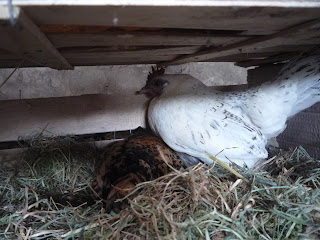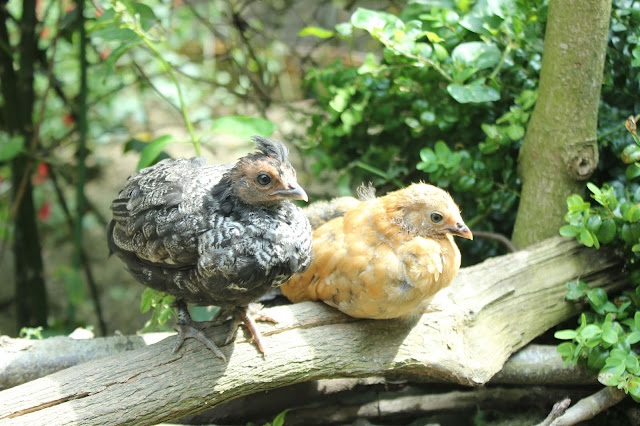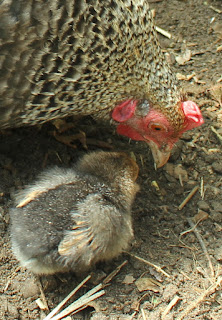This is an on-going series of sounds and body language which I have recorded over many months. I'm hoping it will illustrate, for example, that there is more to chicken speak than just; 'Good Morning - All's well', 'Good Afternoon - All's well' and the seemingly similar but motivationally different, loving actions of a mother to her chicks and the quasi-chivalry of the male. In this section I also want to explore a secondary but most import consideration; viz., who is talking to whom and why.
With the domestication of birds, something else must have entered their language, another element which was not there in the wild, namely us. Our poultry not only have themselves, the flock and other wild birds to listen to and communicate with but they have also had to consider how we are inextricably linked into the process of their daily lives.
A soon as we started to keep fantails, or rather had them thrust upon us, (I thought I was rehoming a Frizzle but had to take five fantails and a dove as well), I realised that pigeons communicate very directly to humans through body language. Our fantails have a very fine idea of hierarchy, seeing the human as an arbitrator, whereas I always get the idea that my chickens see me as a rather obtuse individual who needs continual reminders.
Bird to Human Non-vocal Communication
A soon as we started to keep fantails, or rather had them thrust upon us, (I thought I was rehoming a Frizzle but had to take five fantails and a dove as well), I realised that pigeons communicate very directly to humans through body language. Our fantails have a very fine idea of hierarchy, seeing the human as an arbitrator, whereas I always get the idea that my chickens see me as a rather obtuse individual who needs continual reminders.
I call this 'Ready for the Off' as I feel sure they can read French!
I checked with friends who keep pigeons and they have experienced the same communication pattern. In times of dispute or need, an individual pigeon, who may be sent, for all I'm aware as a representative aka spokesfantail of the group, will fly down from the dovecote and knock on the window with its beak. It will then stare into the kitchen until I come and find out what is wrong. This is usually a case of a problem bird, stealing nesting material or trying to evict another bird from its pigeon hole. For more mundane matters, such as needing more food, water or oyster shell, a fantail will come up to me, block my path and stare with telepathic intensity until I hopefully divine or at least go and find out, what is wrong. Interestingly enough pigeons use vocal language very sparingly, as do doves. In my experience it seems for the exclusive use of babies communicating their needs to parents, for courtship and defence.
Pigeons are supposed to have highly advanced thought processes, which is why they have had a long and for them a not particularly pleasant association with man and his wars. If you search for pigeons and their role in the World Wars you will find some incredible tales of trained carrier pigeons and to what lengths they will go to complete a designated task. Pigeons have been used in many aspects of human life, including communication, carrying both information and light freight; such as medicines and blood samples, in sports such as pigeon racing and of course in entertainment; magic acts. Pigeons can also comprehend quite difficult concepts, e.g., MSR (mirror self-recognition). Maybe therefore, they have decided that it is foolish to waste words on a human, when staring until the latter gets so unnerved as to do something, will serve.
The
Pigeon photographers of Dresden c.1907 and a fine example of their
photography made into picture postcards and sold at the 1909
International Photographic Exhibition.
A Tale of Two Mothers - non-typical behaviours and vocalisations
Situations arise from time to time which bring to my notice new 'words' and or phrases in the chicken vocabulary. It is useful to analyse these sounds and the accompanying body language, as they help in mutual understanding and enable us to troubleshoot potentially difficult situations.
New Mother Communicating Extreme Distrust
The following sound I have heard only once before, it is rare and I've only heard it from another mother hen. I can only describe it as a sob, it comes deep from within the bird and I dare anyone who cares about their flock to be unmoved by it. It also only seems to happen when I am in close proximity to the bird and this factor coupled with the nature of the communication, seems to clearly indicate to me that the answer to my above question; 'to whom', is, 'to me'.
If you compare the pattern of sounds for the 'sob' as recorded on a specific occasion, you will see here as Midnight comes through the door of the house and sees her chicks are safe, the length of the phrase and its volume begin to diminish. I recorded these sounds after she was beginning to get more accustomed to me. When she started with this behaviour and vocalisation it was far too difficult to film. Now I can hear her voice as much calmer and holding her at the time, I could feel the full emotion of the tremor that went through her as she made these sounds. As I say in the film, it doesn't do much for your confidence as a chicken keeper!
The case study of itself is interesting. The mother hen 'Midnight' was not hatched here. She is in fact the offspring of a couple I sold several years ago to my neighbour, to be given as a Birthday present to their son who was starting up a flock. In fact this hen is the exact, pardon the pun, carbon copy of her mother/grandmother and has the dramatic possibilities of her magnificent Ardenner cross frizzled father/grandfather (left). The hen and her sister were returned to my neighbour last year after a visit from the fox had wiped out the rest of the flock. These two hens, not surprisingly were very wild. They spent the first day in the tall trees of the hedge between our gardens and then the next morning descended on our side of the fence and have been here ever since. They have remained a shadowy presence, both being jet black and well-camouflaged by the dense undergrowth of the orchard part of our forest garden. It took them six months to come to eat at the plates whilst we were still in sight. Recently, Midnight found a clutch of eggs or rather laid them, in an old cold-frame. They were well on their way to hatching when I found her.
If you compare the pattern of sounds for the 'sob' as recorded on a specific occasion, you will see here as Midnight comes through the door of the house and sees her chicks are safe, the length of the phrase and its volume begin to diminish. I recorded these sounds after she was beginning to get more accustomed to me. When she started with this behaviour and vocalisation it was far too difficult to film. Now I can hear her voice as much calmer and holding her at the time, I could feel the full emotion of the tremor that went through her as she made these sounds. As I say in the film, it doesn't do much for your confidence as a chicken keeper!
The case study of itself is interesting. The mother hen 'Midnight' was not hatched here. She is in fact the offspring of a couple I sold several years ago to my neighbour, to be given as a Birthday present to their son who was starting up a flock. In fact this hen is the exact, pardon the pun, carbon copy of her mother/grandmother and has the dramatic possibilities of her magnificent Ardenner cross frizzled father/grandfather (left). The hen and her sister were returned to my neighbour last year after a visit from the fox had wiped out the rest of the flock. These two hens, not surprisingly were very wild. They spent the first day in the tall trees of the hedge between our gardens and then the next morning descended on our side of the fence and have been here ever since. They have remained a shadowy presence, both being jet black and well-camouflaged by the dense undergrowth of the orchard part of our forest garden. It took them six months to come to eat at the plates whilst we were still in sight. Recently, Midnight found a clutch of eggs or rather laid them, in an old cold-frame. They were well on their way to hatching when I found her.
If the mother doesn't trust you, she will imprint that distrust onto the chicks!
Since I lost two hens in similar circumstances to a predator a couple of years back, now when I find a sitting hen I bring her into the house. There is usually a single return back-to-base after being let out the first morning after being moved. Thereon in the hen remembers and contents herself with sitting in the house to finish the hatch in comfort and security. Not so Midnight, she insisted on sitting in the cold frame, so I was obliged to return her and the eggs to it every morning and so I guessed we were in for a bumpy ride. Once the chicks started to hatch and despite her very vocal and demonstrative pecking protest, I removed her into the house. I took her out each day with the chicks to an enclosed run in the garden. Unlike my other two hens, who had hatched chicks around the same time, I could not trust her to free-range during the day and return at night. Every evening, I brought her in under protest, sobbing at me as I put the wild and fearful Midnight-imprinted chicks into a box to bring them in. Combined with this vocalisation, she was physically and viciously pecking me the whole time I carried her down the garden. The pecking (though I protected my arms!) lasted for three weeks and the sobbing still happens now and again but it has recently reduced to one single sob and I'm sure it means 'I've still got my eye on you'. Ironically, her fearful chicks now jump onto my shoulder, feet and hands and Midnight jumps up onto the run to be picked up for the journey home. To me what was going on here is all about trust. My hen was communicating directly to me that she neither knew me, nor had confidence in my actions and that my removal of the chicks from her immediate vicinity was a predatory and permanent action on my part. The sob seemed to me, to convey loss, in response to this I took the specific action you will see in the film. Furthermore, in comparison to my other two mothers both of whom know me and will have communicated this to their chicks, the babies with Midnight are now a lot more trusting and affectionate than those of the other two hatches. It is as if having passed through fire together, we have come to a better understanding of both our characters and dispositions.
Baby sitter needed NOW. Mother hen and her expressive body language
As I mentioned above I had three hatches of chicks in the garden this year, the second one was to a lovely but determined cuckoo coloured hen, who is called Cuckoodora, she had a big, covert hatch last year so this Spring I kept her under surveillance, although she still managed to hatch three chicks! One of the serious problems facing a Mother hen is if she comes on to lay whilst she is still brooding chicks. For most hens there are two options, the chicks are taken with the hen and sit outside the nest box where they can be heard cheeping mournfully, so still in communication, or they are taken right into the nest box and sit with the hen whilst she lays. Here (above), Snow White takes two month-old Chickles into the nest box as she lays an egg. It is a tender moment (included in the coming film), as she actually covers her chick with her wing as she lays and Chickles snuggles underneath her. However, when your chicks are still small and your usual nesting site involves negotiating steps into an outbuilding and then flying to the top of a 1.5 metre straw bag, you have to think about some other options. It was when we were sitting comfortably having a very English cup of afternoon tea and watching an old black and white film that Cuckoodora hurled herself at the back door. She had done this the day before with Andy in the house and he thinking she wanted food, had gone out to feed everyone earlier than usual. However, the morning after this event, I had found that she had laid an egg overnight in the cardboard box she sleeps in with her chicks. The next day I decided to film her just to show
that the action goes with the hen's usual vocalisation when looking for a
nesting site and showing intention to lay. It is no doubt something
chicken-keepers are familiar with but not usually accompanied with such
violent action.
Cuckoodora not only needed the sleeping box to lay her egg but for that and a few subsequent days she also needed the chicks to be in it with her. Again this communication was with a human, she was telling me she wanted to lay but there was a problem, she wanted to know the babies were safe. She mixed vocalisation with action and I find this fascinating as she knew where to come, whom to ask and that she also trusted me to work out what she wanted. There was also a further example of communication this time to the chicks as she talks to them as she is making the nest:-
For ease of listening, I have amplified the particular sections when she is making her 'nesting' sounds and now you can almost hear a turkey-type vocalisation. In the film, you will also see her as above check out the surroundings of the box to make sure it is safe. I have seen this action over and over again with mother hens checking perimeters of a given space whether a run or a box, always with an eye to the safety of their brood.
For ease of listening, I have amplified the particular sections when she is making her 'nesting' sounds and now you can almost hear a turkey-type vocalisation. In the film, you will also see her as above check out the surroundings of the box to make sure it is safe. I have seen this action over and over again with mother hens checking perimeters of a given space whether a run or a box, always with an eye to the safety of their brood.
All alone but together - the trio include identical twins except that one (obscured) is a frizzle!
Shortly afterwards Cuckoodora left the chicks but she still comes down here to the house and repeats the action when she wants to lay. In order not to get another covert hatch, I have rewarded her each day with something nice to eat after laying, however this recently backfired on me, when she came down really early one morning and just sat in the box for a few minutes and then jumped out, obviously she thought she could get the food without the egg!
These are but a few examples of the expressive language of hens, I have so much more to cover and many more examples, so I hope you will join me in the next part, where there will also be a film to illustrate the above.
Meanwhile all the very best and if you have enjoyed this piece and found it interesting and/or useful please feel free to join the blog, subscribe to my youtube channel and of course to ask questions or comment and share your own experiences.
Sue
Pigeon Photographers of Dresden, thanks to the Pinterest Board of petapixel.com
RELATED ARTICLES
If I could talk to the (animals) birds
Looking
at the history and research behind bird communication, marking the
start of a series of articles sharing ideas on how talking helps...read more
Chicken Speak 3 - The Food of Love - How Poultry Express Emotion Through Food
For over two decades I’ve been observing the poultry in the garden and noting the marked changes in behaviour and language. To support and provide some ‘academic’ weight to my ideas about what has happened to my birds and how they have changed over ...read more
© 2016 Sue Cross

















